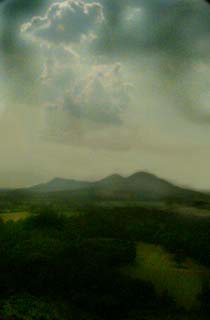Romans and Celts in Scotland

The Eildon Hills
Melrose
The Scottish Borders


Like Edinburgh's Castle Rock, and Arthur's Seat, the great craggy hill which marks the East end of Edinburgh, the Eildon Hills were once volcanic cores; hard rock which has survived while the surrounding has worn slowly away.
About 7000BC the earliest settlers arrived in this area; some of their flint tools have been found near Dryburgh Abbey. Nobody knows when people first began to live on top of the North hill of the Eildons, but by time the Romans had pushed this far North in about 80 AD, there was already established a town of about 300 huts with fortifications surrounding and area of 39 acres. It may have been the headquarters of the Celtic tribe of the Selgovae.
At the foot of this town, and controlling the best ford across the river Tweed, the Romans built an important fortified garrison, and named it after the three peaks of the Eildons: Trimontium.
What relationship did the native Celts have with the Roman army? It may not have been such a clash of cultures as one might expect; much of the Roman army itself consisted of members of various other Celtic tribes from Britain, Gaul and Germany. In past years the Department of Archaeology from Bradford University has been excavating in the area, trying to find out more about this relationship.

An unmistakable landmark in the Borders and only a mile's walk out of Melrose, the Eildon Hills are fascinating for Botanists, Ornithologists, Geologists and Archaeologists alike.
- Celtic Hill Fortifications, ramp and entranceway and hut sites.
- Unusual features thought to be sites of Sacred Groves or Temples.
- Peat Bogs, Acid Heathland, Flushes, Grassland.
- Basalt, Old Red Sandstone, Sanidene and Felsite.
- Resident Red Grouse, variety of heath, water and woodland birds.
